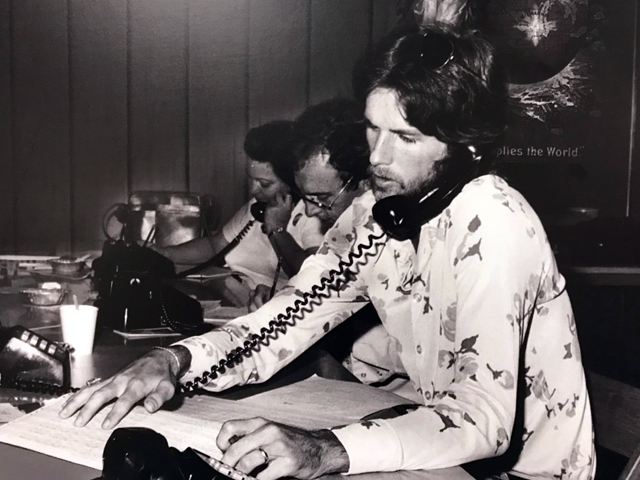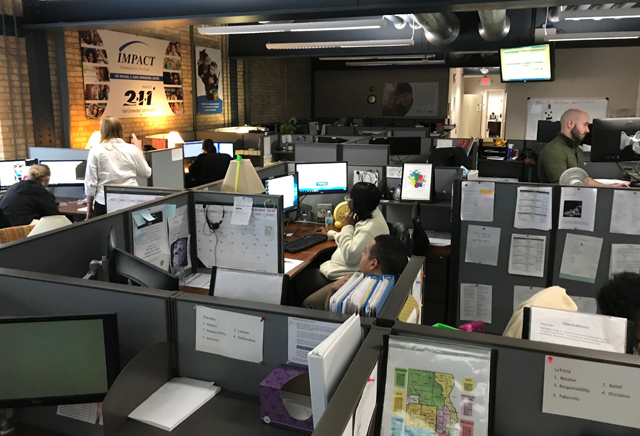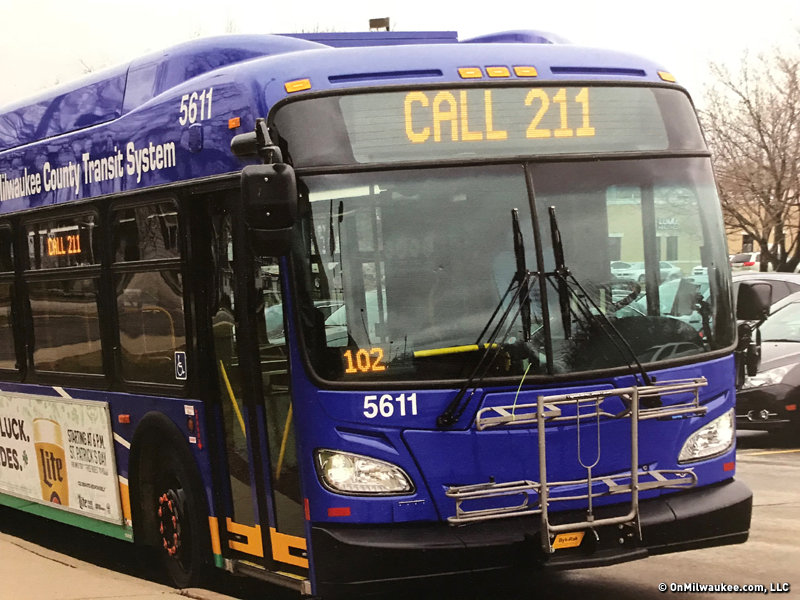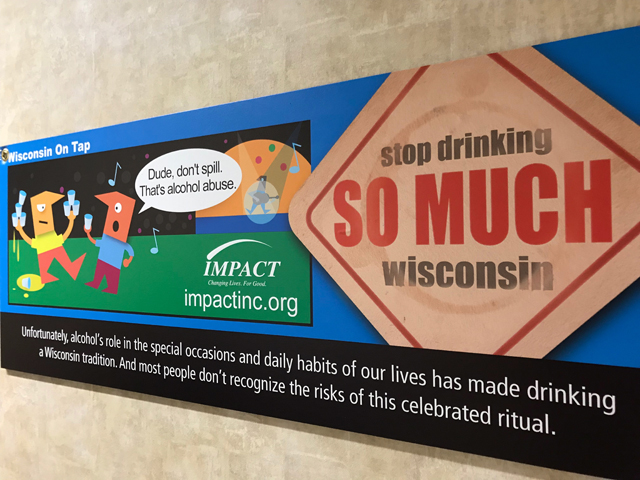In 2016, Milwaukee's IMPACT – which runs the 2-1-1 call center out of a West Allis office complex – handled 153,300 phone calls, 114,341 online sessions and 3,111 text/chat sessions, for a total of 270,741 contacts with Milwaukeeans seeking guidance and assistance on a wide variety of issues.
IMPACT works to connect people in need 24 hours a day, seven days a week with available services in the area on everything from substance abuse, to employment, to hunger, to homelessness and more.
Founded nearly 60 years ago, IMPACT works with the County and other providers to do this work and a wide range of other tasks, too. We wanted to know more, so we sat down with IMPACT President and CEO John Hyatt to learn about the history of IMPACT and the work it does.
Enjoy this Milwaukee Talks with John Hyatt.

OnMilwaukee: It looks like you kind of do everything.
John Hyatt: We are the place where we have this really wide net or funnel (to) family, health and social services. People will say, "I have a mental health issue, I've got a substance abuse issue, I've got a kid with special needs, I don't have food, I don't have housing, I got a parent that's trying to live independently." You call 2-1-1. Or you call IMPACT.
People all come to us in very large numbers, and we've got a database of resources, more than 25,000 programs and services in and around the community. We help people really define the problem; what's at the root cause of it. Then we help them figure out where they can go to get that help or that assistance.
So you are not providers of counseling and things. You're basically a matchmaker, in a sense.
We've been here more than 60 years. For a long time, we were the Milwaukee Council on Alcoholism and Drug Dependence. It was all about substance abuse issues. Mostly alcohol and alcoholism. It continues to be a place where people call us through 2-1-1 or they come into our office for some more specific substance abuse-related issues.
Financially about half of our just a little less than $5 million budget is for stuff that's in the office and the other half is through the call center.
I think the previous 12 months of data we looked at, there were 284,000 requests for help. There's a lot of need here.
We were mostly this place where people would come into the office. We would talk to you, do an assessment and get you connected to something in the community. It turns out, people need a lot of other stuff, too. It wasn't one thing. So we came to the fork in the road and we took it, and we decided we're about other things, too. The things that we did started to get broader.
When in your 60-year history did this happen?
That probably happened about 23 years ago. We also had this thing called the Underground Switchboard. And that's evolved into what's we've become. The stakeholders – the County and United Way and the health department and a number of others – said, "You know we've got all these resources but there's no good way to get to any of them."
So the Underground Switchboard morphed into 2-1-1?
It did, yes. It became the help line, which then became the community information line, which became 2-1-1.
The fact that all these different entities saw this at the same time and actually managed to work together, was that an a-ha moment? Was that an unexpected kind of epiphany?
I think it was. We were saying, we have this infrastructure where we took these calls 24 hours a day, every day of the year. And we knew how to talk to people and we were in the human services arena. We were at the table saying, "Hey, you know there's a better way of doing this." It eventually became consolidated as one. The group of stakeholders put out a request for a proposal and we got on it and we were awarded the program. It brings efficiency to the system.
It has evolved from a community information line to 2-1-1, a national initiative. Most of the country, if you dial 2-1-1, you'll end up in a call center near you.
Doing more or less the same thing?
There's been an evolution within 2-1-1, too. It is at it's core, this basic information and referral service. As time went by, almost from the start though, there was this desire to say, "Well, tell me more about what's happening?" You're looking for a food pantry, tell me more about that. And somebody might say, we've got a substance abuse issue or a gambling problem or I've got health issues and I've got this big health bill and I don't know how to manage that. Or, I've lost my job, my home is foreclosing.
We really help them understand kind of what's at the root of that they're trying to deal with. They're in crisis and we bring some immediate stability to the crisis. Then they have some things that will create some longer term stability.

Your call center employees really are your front line. What does it take to be that person?
A lot of people skills, right? We are on the front line. People are drowning by the time they get to us. We're trying to do everything we can to first of all say, "Let's catch your breath," right?
And, "Thank you for calling, how can we help you?" And just talking like that helps them.
You’ve got to be calm.
You’ve got to be calm. You've got to be reassuring, and it's hard when there are some categories of problems there aren't always good solutions to.
So somebody calls and says, "Look I got an eviction notice and by tomorrow I'm not going to have a place to stay." Sometimes it's people who will say, "Well, call IMPACT." Oh, OK, I'm calling you guys, I'm about $400 short on my rent. OK, so where are you going to come up with that? They're like, "Well I thought that's why I was calling you." We don't write checks.
There occasionally are some programs where they can do rent assistance, but those are so limited. Then it becomes these other questions about you know, who could you stay with?
Or who have you stayed with? Or you've got an eviction notice, there’s some things you can do about that. Let's connect you to somebody that can help you.
You have to talk people through. Again, sometimes that's not what they want and so you get through all of that and they're like, "Yeah, no, none of that's for me."
Do you find that you have to, in a sense, counsel your counselors too?
Yep.
I imagine that this job has euphoric highs, like when the guy calls you and says, thanks.
Yeah it does.
Then you get people saying, "Well thanks for nothing," and hanging up on you.
Right. Or they're just talking into the phone saying, "I'm not sure, I don't know what I'm going to do and I'm desperate." We've had the call where the guy says, "I got a bottle in one hand and a gun in the other, you need to convince me why I shouldn't pull the trigger." We get those calls.
It is, call after call after call, people not having a great day. Some of them you give some really good resources and some really good help. And they'll say, "God bless you, I don't know what I would have done if I hadn't called you guys, thank you so much." Then there are other people that say, "So you really couldn't help me at all; why should I have wasted my time talking with you?" And there are other people that are still saying, "You know, thank you for trying, thank you for helping and I have some things here (I can try)."
There are some who are disappointed that we can't help them with what it is that they're looking for. There are gaps in services in the community.
It is, again, you talk about the gap in expectations and you know, so what I'll say to people is, "No matter what, if we're kind, if we're welcoming, if we're helpful. If we're doing everything we can, we've given that person a good experience." They know that somebody cares, that somebody is on their side, that if something else comes up later, they know they can always call us back.
Again, it's trying to adjust your expectations. It's like (the call center workers) will say, "So, I should care less?" No, you shouldn’t care less about it. You work as hard as you can. You search as far as you can search. But you can't expect that if you've got 50 calls in a day, you're going to have exactly what every one of those 50 caller needs.
Is retention difficult for you guys? Does it take enough of an emotional toll to people who can't really do this job for a long time?
I would sort of say yes. But I would also say no. There are some people that have been working out there for three or four years. That's a long time. If you're going to have burnout, it's going to hit you before three or four years.
There's some people that go for nine months or 12 months, and they're just like you know, "I, it's just too hard, I can't leave it at work, I'm taking it home with me."
People think of it as an entry-level position, "I'll use this on my way to a job, where I sit and I talk with somebody across the table or I'm out on the street. I'm on my way to my next thing." There's a lot of turnover out there, which is one of our challenges.
We've got about 19 full-time equivalents, which is about 30 people taking calls 24 hours a day, seven days a week. We'll turn that over in about a year and a half.
Is it challenging to fill those positions?
It kind of comes and goes. We were really struggling for a while and now all of a sudden, we've got some really good candidates and we've hired some really good people. I don't know that there's an explanation for why that is. The economy is good right now; we're not paying people a ton of money.
We're a nonprofit. I'd love to pay people 20 bucks an hour. I can't. They start at around 13 and a half or 14 bucks an hour, so often it's, "Yeah, I love the work here, I love what I'm doing. Even the place that I'm going to is not my dream job but I can make a couple more bucks an hour and so, that's on mind and I'm going on to the next thing."
How many people work in the office?
There are about 65 of us total. There are about 30 that take calls. There's a call center manager, there's a call center supervisor. The database needs regular updating, so there are three positions dedicated to just doing that. There are those people answering the phone and then those other people that serve and support their work.
Is our funding still reliant on this RFP model? What does that look like?
Yes, with the County, we have a request for information, our RFI, we still have to, and for United Way, who are our two single largest supporters. We still have to apply every year. I think we feel pretty confident because we've gotten support from them every year.
Essentially, the money for 2-1-1, coming from the County, is the same it was 15 years ago. United Way was sort of ticking up every year, until a few years ago. Then you're like every other nonprofit, where you're seeing where else can we get money from. Then you're trying to beg and borrow and steal and approach donors and granters and funders and foundations and all that kind of stuff and piece it together.
Tell me about some of the other things IMPACT does.
We partner with Milwaukee County. They have a substance abuse program for people where if you're uninsured or if you're under-insured, you can come in, we'll do a comprehensive assessment in the office. When you leave, you will have an appointment with somebody to go get your treatment.
We'll see in that program around 1,500 or 2,000 people a year. The number is only that low because that's the number of staff that we have. If we had twice as many people, we'd have twice that many people we could assist.
It's not for a shortage of people in need, it's for a shortage of staff?
Yes. There's another part of what we do, too. It's our planning and evaluation program. We work with a lot of nonprofits and other organizations that are trying to determine the effectiveness and the outcomes of their programs.
We work with that organization around, what are, what kind of outcomes can you have? What do you need to be doing to collect the data to be able to say we've achieved the outcome or we haven't? What are the processes in place for collecting that? How do we analyze that, help you? How do we sample that into a report? We work with a lot of organizations in that way, to help them try and figure out, if the program’s successful or not, are the approaches successful or not.
How many do you think you work with?
You know, we've worked with hundreds. And at any given time, we've probably got somewhere between five and 10 of those kinds of projects going on.
Another kind of thing that we do is this initiative called Stop Drinking So Much Wisconsin. It's not a stop drinking altogether initiative. It's a stop drinking so much. We're one of the states that are the heaviest consumers of alcohol. And we are several years running, the drunkest state in the country. We do more binge drinking. In any community, you have a small group of people that are alcohol dependent alcoholics. Some are between 2 and 5%, something like that. In Wisconsin, we have this really giant bubble that goes out to about 45% of people that drink in a way that creates risk for them.
We also do all of the drunk driving assessments in Milwaukee County. In the state, every county has a designated assessment agency and we've been doing that in Milwaukee for 30 or 35 years, something like that.
What does that entail?
You get convicted of drunk driving, if you want your drivers license back, you got to pay fines and penalties. You also have to get an alcohol and drug assessment. That's what we do. We determine what level of care, you need education, you need treatment. Everybody has to do something.
We track people, to make sure you're doing the stuff you need to do. We do about 4,000 of those every year.
You said, that the guy that was sitting out there, had a better than 50% chance of being here for opioids?
The reason I said 50% is because for those people that are coming in for a non drunk driving, way more than half of them are opiates and heroin.
That seems astonishing.
The calls coming through into the 2-1-1 call center for substance abuse are way more opioid and heroin than anything else. Ten years ago, we had very few opioid and heroin calls or clients. It's just skyrocketed.
Are you able to match them with resources? Are the available resources keeping up with the problem?
The simple answer is no. Even if you have health insurance and can get into a program, it will likely take you several weeks before you can get an appointment. That's a long time. A lot can happen in three weeks. Then there's the question of what's affordable? Even if you have health insurance, have you got the $3,000 deductible? Or 2,000 or 1,000. Or 80%, it's still really expensive.
It has to be easier to get treatment than heroin. It's not right now. It is both availability and affordability. No amount of education and all that kind of stuff is going to prevent enough people from having the problem. You just got to throw a bunch of money at it and nobody likes hearing that.
It's all about dollars and cents. It just is. If you don't have enough people to treat cancer, more people are going to die of cancer. If you don't have more people to treat heroin, more people are going to die of heroin. When you're using substances, people are not sympathetic.
Unless you can get away from thinking like that, nobody will ever have the will to be able to say, even if it means raising taxes, we have to spend more money on this. This might be the one thing that is broad enough and deep enough, that there are enough people who are starting to have loved ones die from opiates and heroin, that might eventually get that kind of support behind it.
We were doing this project with the Greenfield Police Department and a guy there said, "More than 90% of the people that we encounter in law enforcement every day are opiate and heroin addicts."
It's theft, it's burglary, it's break-ins. It's just all that stuff. And it's the people ODing, too. So what's just the cost of that? Now you've got your law enforcement all tied up in this issue. It's churning through health care dollars, accidents and injuries and broken families.
At some point it impacts all of us so much that you're just going to have to put some more money into that and try to help people in that way.


Born in Brooklyn, N.Y., where he lived until he was 17, Bobby received his BA-Mass Communications from UWM in 1989 and has lived in Walker's Point, Bay View, Enderis Park, South Milwaukee and on the East Side.
He has published three non-fiction books in Italy – including one about an event in Milwaukee history, which was published in the U.S. in autumn 2010. Four more books, all about Milwaukee, have been published by The History Press.
With his most recent band, The Yell Leaders, Bobby released four LPs and had a songs featured in episodes of TV's "Party of Five" and "Dawson's Creek," and films in Japan, South America and the U.S. The Yell Leaders were named the best unsigned band in their region by VH-1 as part of its Rock Across America 1998 Tour. Most recently, the band contributed tracks to a UK vinyl/CD tribute to the Redskins and collaborated on a track with Italian novelist Enrico Remmert.
He's produced three installments of the "OMCD" series of local music compilations for OnMilwaukee.com and in 2007 produced a CD of Italian music and poetry.
In 2005, he was awarded the City of Asti's (Italy) Journalism Prize for his work focusing on that area. He has also won awards from the Milwaukee Press Club.
He has be heard on 88Nine Radio Milwaukee talking about his "Urban Spelunking" series of stories, in that station's most popular podcast.




.jpg)


